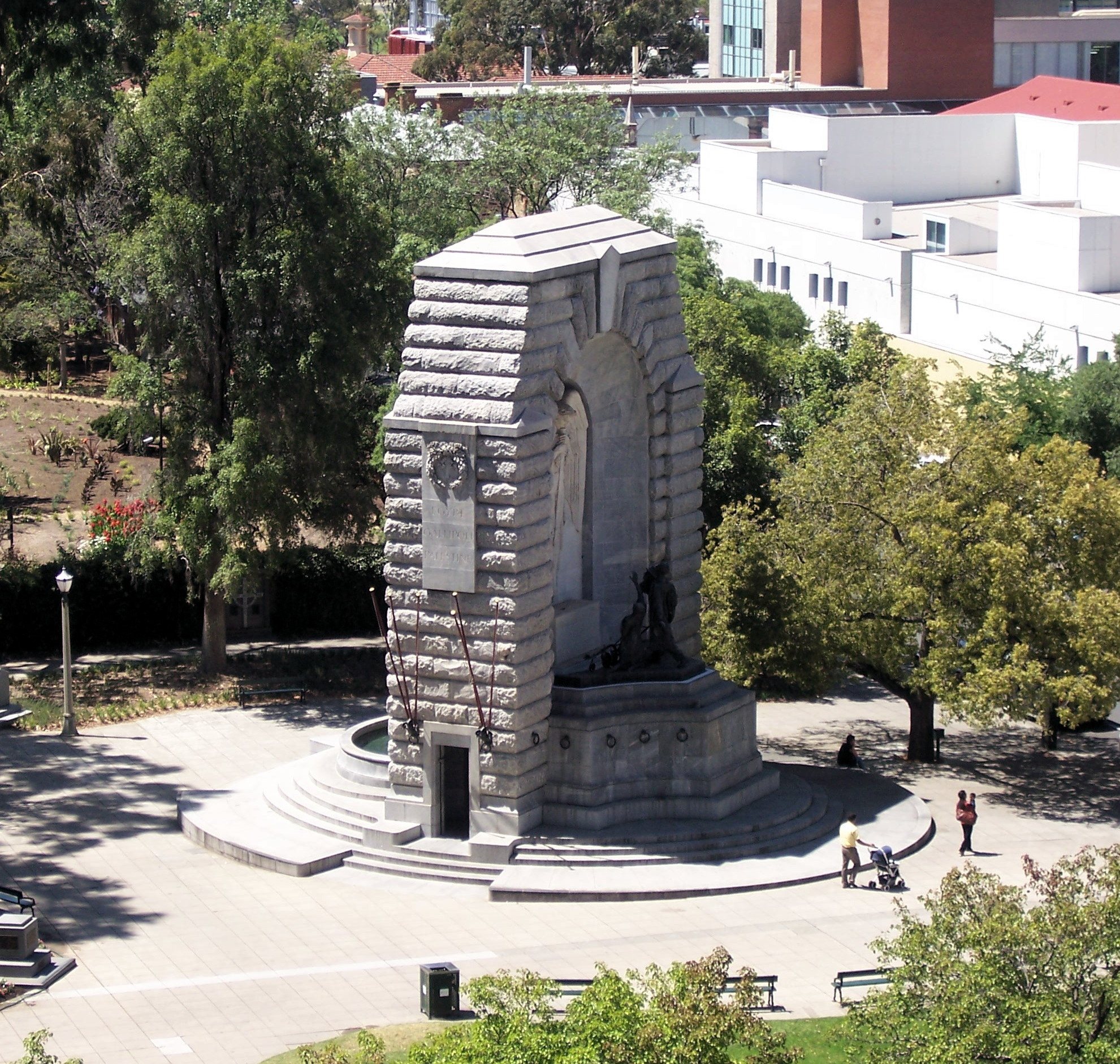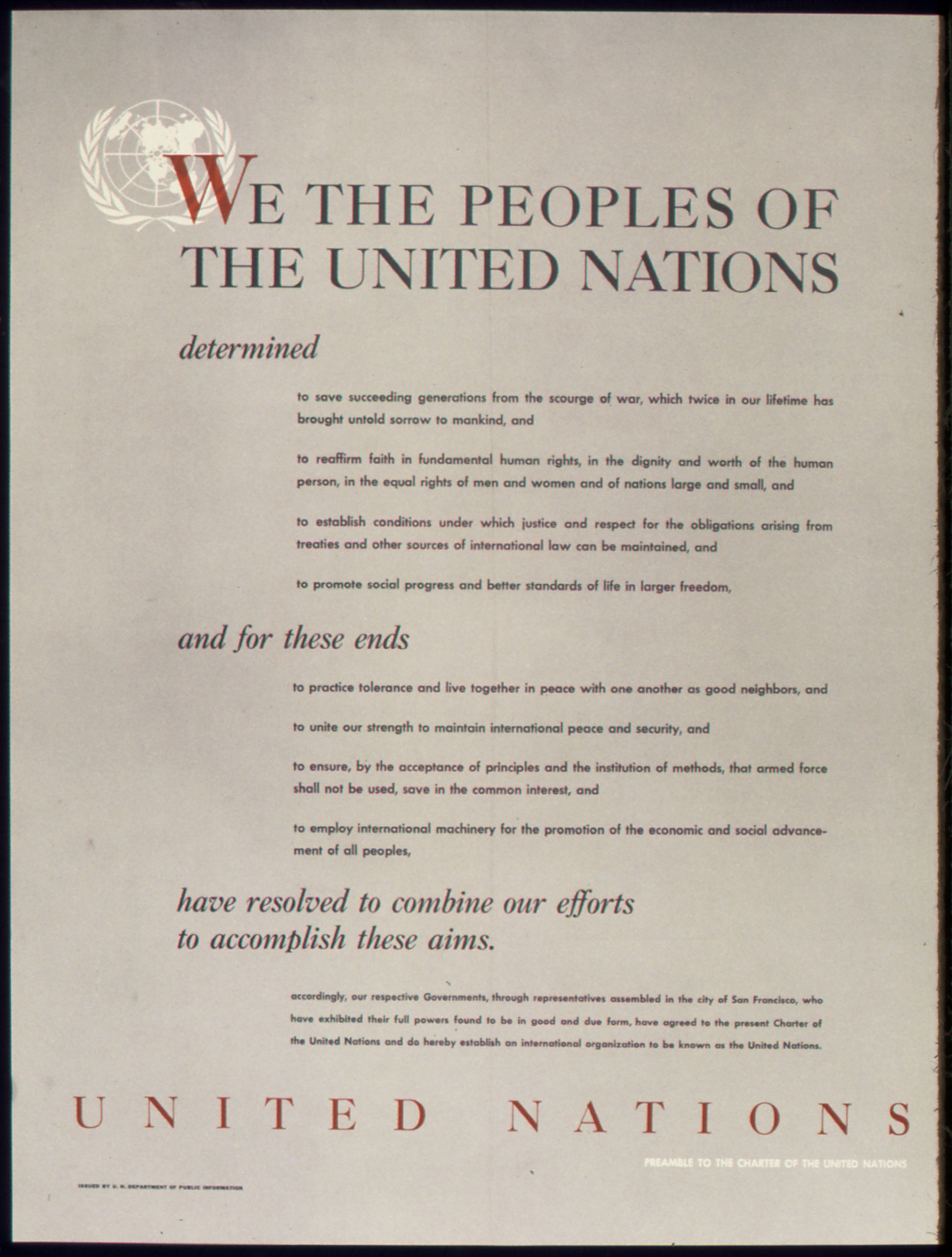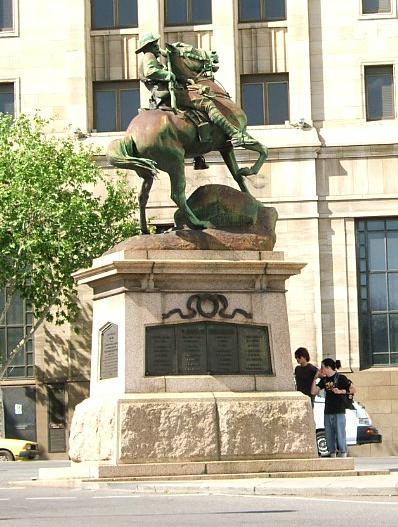|
National War Memorial (South Australia)
The National War Memorial is a monument on the north edge of the city centre of Adelaide, South Australia, commemorating those who served in the First World War. Opened in 1931, the memorial is located on the corner of North Terrace and Kintore Avenue, adjacent to the grounds of Government House. Memorial services are held at the site throughout the year, with major services on both Anzac Day (25 April) and Remembrance Day (11 November). First proposed in 1919, the memorial was funded by the Parliament of South Australia, making it the first Australian state war memorial to be confirmed after the war. The design of the memorial was selected through two architectural competitions. The first competition, in 1924, produced 26 designs—all of which were lost before judging could be completed after fire destroyed the building in which they were housed. A second competition, in 1926, produced 18 entries, out of which the design by the architectural firm Woods, Bagot, Jory ... [...More Info...] [...Related Items...] OR: [Wikipedia] [Google] [Baidu] |
Adelaide War Memorial-2
Adelaide ( ) is the capital city of South Australia, the state's largest city and the fifth-most populous city in Australia. "Adelaide" may refer to either Greater Adelaide (including the Adelaide Hills) or the Adelaide city centre. The demonym ''Adelaidean'' is used to denote the city and the residents of Adelaide. The Traditional Owners of the Adelaide region are the Kaurna people. The area of the city centre and surrounding parklands is called ' in the Kaurna language. Adelaide is situated on the Adelaide Plains north of the Fleurieu Peninsula, between the Gulf St Vincent in the west and the Mount Lofty Ranges in the east. Its metropolitan area extends from the coast to the foothills of the Mount Lofty Ranges, and stretches from Gawler in the north to Sellicks Beach in the south. Named in honour of Queen Adelaide, the city was founded in 1836 as the planned capital for the only freely-settled British province in Australia. Colonel William Light, one of Adelaide's found ... [...More Info...] [...Related Items...] OR: [Wikipedia] [Google] [Baidu] |
Kintore Memorial
{{disambiguation, geo ...
Kintore may refer to: __NOTOC__ Places Australia * Kintore, Northern Territory * Kintore, Western Australia * Kintore Avenue, a street in South Australia * County of Kintore, South Australia Canada * Kintore, Ontario * Lower Kintore, New Brunswick * Upper Kintore, New Brunswick Scotland * Kintore, Aberdeenshire Other uses * Kintore (Parliament of Scotland constituency) * Earl of Kintore Earl of Kintore is a title in the Peerage of Scotland. It was created in 1677 for Sir John Keith, third son of William Keith, 6th Hereditary Earl Marischal of Scotland (see Earl Marischal for earlier history of the family) and Chief of Clan ... [...More Info...] [...Related Items...] OR: [Wikipedia] [Google] [Baidu] |
Australian Institute Of Architects
(United we advance architecture) , predecessor = , merged = , successor = , formation = , extinction = , status = Professional body; members association , headquarters = L1/41 Exhibition St, Melbourne , leader_title = CEO , leader_name = Barry Whitmore (Acting) , leader_title2 = President , leader_name2 = Shannon Battisson , leader_name3 = , leader_title3 = , leader_title4 = , leader_name4 = , board_of_directors = , key_people = , subsidiaries = NSW ChapterVIC ChapterQLD ChapterSA ChapterWA ChapterTAS ChapterNT ChapterACT Chapter , affiliations = International Union of Architects , name = Australian Institute of Architects , abbreviation = RAIA , founder = , founding_location = , location = Melbourne , region = Australia , fields = Architecture , membership = , membership_year = , budget_year = , staff = , staff_year = , website Architecture.com.au The Australian Institute of Architects (officially as the Royal Australian Institut ... [...More Info...] [...Related Items...] OR: [Wikipedia] [Google] [Baidu] |
Guinea (British Coin)
The guinea (; commonly abbreviated gn., or gns. in plural) was a coin, minted in Great Britain between 1663 and 1814, that contained approximately one-quarter of an ounce of gold. The name came from the Guinea region in West Africa, from where much of the gold used to make the coins was sourced. It was the first English machine-struck gold coin, originally representing a value of 20 shillings in sterling specie, equal to one pound, but rises in the price of gold relative to silver caused the value of the guinea to increase, at times to as high as thirty shillings. From 1717 to 1816, its value was officially fixed at twenty-one shillings. In the Great Recoinage of 1816, the guinea was demonetised and the word "guinea" became a colloquial or specialised term. Although the coin itself no longer circulated, the term ''guinea'' survived as a unit of account in some fields. Notable usages included professional fees (medical, legal, etc.), which were often invoiced in guineas, a ... [...More Info...] [...Related Items...] OR: [Wikipedia] [Google] [Baidu] |
British Subject
The term "British subject" has several different meanings depending on the time period. Before 1949, it referred to almost all subjects of the British Empire (including the United Kingdom, Dominions, and colonies, but excluding protectorates and protected states). Between 1949 and 1983, the term was synonymous with Commonwealth citizen. Currently, it refers to people possessing a class of British nationality largely granted under limited circumstances to those connected with Ireland or British India born before 1949. Individuals with this nationality are British nationals and Commonwealth citizens, but not British citizens. The status under the current definition does not automatically grant the holder right of abode in the United Kingdom but most British subjects do have this entitlement. About 32,400 British subjects hold active British passports with this status and enjoy consular protection when travelling abroad; fewer than 800 do not have right of abode in the UK ... [...More Info...] [...Related Items...] OR: [Wikipedia] [Google] [Baidu] |
Nellie Melba By Henry Walter Barnett
Nelly (born 1974) is an American rapper, singer, actor and entrepreneur. Nelly or Nellie may also refer to: Places * Nellie, Ohio, an American village * Nellie, Assam, a town in Nagaon district * Nelly Island, Antarctica * Nelly Island, Bermuda * Mount Nelly, Bolivia, a stratovolcano in the Andes People * Nelly (given name), a list of people with the given name or nickname Nelly or Nellie * Nelly (Egyptian entertainer), Egyptian singer, actor, and radio and television personality and presenter * Nelly Furtado, a Canadian singer, songwriter and record producer * Nelly's (1899–1998), Greek photographer (real name Elli Souyioultzoglou-Seraïdari) * Harry Nelly, head coach of the Army college football program from 1908 to 1910 Arts and entertainment * Nelly (2004 film), a French film * Nelly (2016 film), a Canadian film * ''Nellie'', a boat in Joseph Conrad's novella ''Heart of Darkness'' Other uses * , a Danish steamship in service between 1928 and 1936 * "Nellie", a prot ... [...More Info...] [...Related Items...] OR: [Wikipedia] [Google] [Baidu] |
Preamble
A preamble is an introductory and expressionary statement in a document that explains the document's purpose and underlying philosophy. When applied to the opening paragraphs of a statute, it may recite historical facts pertinent to the subject of the statute. It is distinct from the long title or enacting formula of a law. In parliamentary procedure using Robert's Rules of Order, a preamble consists of "Whereas" clauses that are placed before the resolving clauses in a resolution (formal written motion). However, preambles are not required to be placed in resolutions. According to Robert's Rules of Order, including such background information may not be helpful in passing the resolution. Legal effect While preambles may be regarded as unimportant introductory matter, their words may have effects that may not have been foreseen by their drafters. France In France, the preamble to the constitution of the Fifth Republic of 1958 was considered ancillary and therefore no ... [...More Info...] [...Related Items...] OR: [Wikipedia] [Google] [Baidu] |
Australian Federation
The Federation of Australia was the process by which the six separate British self-governing colonies of Queensland, New South Wales, Victoria, Tasmania, South Australia (which also governed what is now the Northern Territory), and Western Australia agreed to unite and form the Commonwealth of Australia, establishing a system of federalism in Australia. The colonies of Fiji and New Zealand were originally part of this process, but they decided not to join the federation. Following federation, the six colonies that united to form the Commonwealth of Australia as states kept the systems of government (and the bicameral legislatures) that they had developed as separate colonies, but they also agreed to have a federal government that was responsible for matters concerning the whole nation. When the Constitution of Australia came into force, on 1 January 1901, the colonies collectively became states of the Commonwealth of Australia. The efforts to bring about federation in th ... [...More Info...] [...Related Items...] OR: [Wikipedia] [Google] [Baidu] |
Ken Inglis
Kenneth Stanley Inglis, (7 October 1929 – 1 December 2017) was an Australian historian. Early life and education Inglis was born in the Melbourne suburb of Ivanhoe, on 7 October 1929, the son of Stan and Rene Inglis. He was educated at Tyler Street Public School, Northcote Boys' High School and Melbourne High School, before going to study at the University of Melbourne. Inglis participated in the Student Christian Movement and amateur dramatics during his studies, and worked as a tutor at Ormond College. After graduating with a Bachelor of Arts with first class honours in History and English, he read for a Master of Arts at Melbourne. Inglis's thesis, which was a history of the Royal Melbourne Hospital, was later revised and published as his first book, ''Hospital and Community'' (Melbourne University Press, 1958). Career Inglis completed his Master's degree at the University of Melbourne and his doctorate at the University of Oxford. In 1956 he was appointed as a lecturer t ... [...More Info...] [...Related Items...] OR: [Wikipedia] [Google] [Baidu] |
Second Boer War
The Second Boer War ( af, Tweede Vryheidsoorlog, , 11 October 189931 May 1902), also known as the Boer War, the Anglo–Boer War, or the South African War, was a conflict fought between the British Empire and the two Boer Republics (the South African Republic and the Orange Free State) over the Empire's influence in Southern Africa from 1899 to 1902. Following the discovery of gold deposits in the Boer republics, there was a large influx of "foreigners", mostly British from the Cape Colony. They were not permitted to have a vote, and were regarded as "unwelcome visitors", invaders, and they protested to the British authorities in the Cape. Negotiations failed and, in the opening stages of the war, the Boers launched successful attacks against British outposts before being pushed back by imperial reinforcements. Though the British swiftly occupied the Boer republics, numerous Boers refused to accept defeat and engaged in guerrilla warfare. Eventually, British scorched earth po ... [...More Info...] [...Related Items...] OR: [Wikipedia] [Google] [Baidu] |
South African War Memorial (South Australia)
The South African War Memorial (also known as the Boer War Memorial or, prior to 1931, the National War Memorial) is an equestrian memorial dedicated to the South Australians who served in the Second Boer War of 11 October 1899 to 31 May 1902. It was the first war in which South Australians fought, and 1531 men were sent in nine contingents, with over 1500 horses to accompany them. Over 59 South Australians died in the war. The memorial is located in front of the main entrance to Government House, one of the most prominent buildings in Adelaide, on the corner of North Terrace and King William Road. It was constructed with a budget of £2,500 raised through public donations, and was designed by the London-based sculptor Adrian Jones. While the statue itself was not intended to represent any particular soldier, there is evidence suggesting that the head of the rider was based on that of George Henry Goodall. The statue was unveiled by the Governor of South Australia, Geor ... [...More Info...] [...Related Items...] OR: [Wikipedia] [Google] [Baidu] |
South Australian Legislative Council
The Legislative Council, or upper house, is one of the two chambers of the Parliament of South Australia. Its central purpose is to act as a house of review for legislation passed through the lower house, the House of Assembly. It sits in Parliament House in the state capital, Adelaide. The upper house has 22 members elected for eight-year terms by proportional representation, with 11 members facing re-election every four years. It is elected in a similar manner to its federal counterpart, the Australian Senate. Casual vacancies—where a member resigns or dies—are filled by a joint sitting of both houses, who then elect a replacement. History Advisory council At the founding of the Province of South Australia under the '' South Australia Act 1834'', governance of the new colony was divided between the Governor of South Australia and a Resident Commissioner, who reported to a new body known as the ''South Australian Colonization Commission''. Under this arrangement, ther ... [...More Info...] [...Related Items...] OR: [Wikipedia] [Google] [Baidu] |







